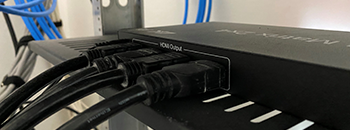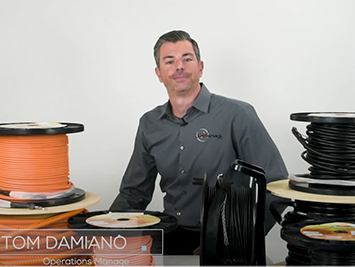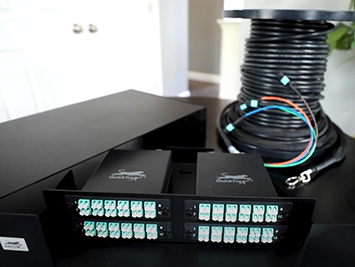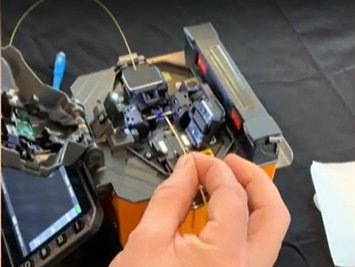Electrical contractors are increasingly moving into network installation as a way of offsetting the lack of new construction projects.
By Dan Carazo
According to Mara White, marketing manager DCI, CSP, for Fluke Networks (flukenetworks.com), the construction slowdown has resulted in many electricians vacating the standard power wiring space and entering the low-voltage/datacom wiring market. In addition, manufacturers have seen a marked rise in the technical education level of the datacom installer and network technician as the industry segment has matured. White claims it is the VoIP, PoE, and security applications that have continued driving the requirement for new tools. "All of these require the installation, testing, and troubleshooting of physical LV cabling, primarily Ethernet twisted pair and fiber at the head ends," said White. "This is an advantage to all tool manufacturers and their distributors as the move from simple single task tools to more advanced multiuse tools has become more prevalent."
Jeremy Corn, datacom marketing support for IDEAL Industries (ideal industries.com), sees this expansion of Ethernet devices into applications like VoIP, IP network cameras, and industrial networks as an important shift that is driving greater demand for network verification products.
"What was once the domain of coax cable with type F and BNC connectors is now UTP and RJ-45," said Corn. "Installers of communications cabling in security, IPTV, and other growing niche markets may be new to UTP and Ethernet. What they welcome in a handheld tester is a user-friendly interface and test results that are presented in a clear, concise fashion for interpretation.
"For less than $200, contractors can purchase a full-featured Ethernet verifier with a large backlit LCD, length testing, and multiple remotes," he added, explaining that testers that are simple enough to be used straight out of the box are extremely popular, especially for novice network installers.
"Most techs don’t need reams of test results; they just need to know if the cabling they’ve installed works or not," Corn continued. "A basic troubleshooting tester will find opens, shorts, reversals, split pairs, and miswires."
While Klein Tools (kleintools.com) is the new kid on the block when it comes to application-specific VDV testers and tools, the company is benefitting from the same trends that are reshaping network system design and performance.
Christopher Niklas, product manager, VDV products, for Klein Tools, confirmed how products in this category are changing. "For coax, it is the overall adoption of the compression connectors; in modular connectors, it is the proliferation of the data port on everything from security cameras to mainstream television sets," he explained. "And in testers, it is the over all improved ease of use and advancements in materials."
The use of fiber-optics is increasing as well with the build-out of the backbone from the service providers. This means that the inclusion of fiber testing into multitask tools for cabling verification will continue to expand.
"Fiber is a growth market," confirmed White, noting that he sees more growth in fiber for the next five years. "Requirements for increased bandwidth and demand for the faster data rates that are needed for expanding technology like streaming video, VoIP, and PoE are extending the fiber-optic networks closer to the users," White continued, adding that the security market is very active and likely to generate continued demand for affordable, intuitive, qualification testers that can document cabling installations.
"The need to qualify cables for voice, VoIP, and 10/100/1000 Ethernet will increase the importance of troubleshooting with a variety of innovative built-in technologies like TDR and multimap, which provide greater vision to locate faults and speed up problem resolution," explained White.
"Reasonably priced multifunction tester/tracer units that contain the right mix of features are in demand because typical eight-pin testers and traditional tone and probe units fall short of current installer needs," said Tony Casazza, president of QuickTreX (quick trex.com).
According to Corn, Ethernet use in industrial and plant floor environments has grown dramatically in the past five years, highlighting the importance of ruggedly designed testers. "Ethernet has moved onto the plant floor in industrial networks and outdoors into IP network security systems," he said. "Testers get dropped and are subjected to terrible weather, plus industrial Ethernet requires an M-12 port on the tester."
Casazza pointed out the growing popularity of toolkits containing a complete set of professional electro/tech tools that is ideal for companies that maintain their own facilities. "Organizations that typically hire full-time technicians for faster service and cost savings will continue this trend for the next few years," said Casazza.
Wire and Kevlar Cutting Scissors
QuickTreX offers Wire Surgeon electricians' wire and Kevlar cutting scissors. Crafted in Germany of durable ice-tempered Solingen stainless steel that holds up under extreme use, the scissors—which are used for installing structure network cabling—incorporate a wire stripper and splice and a terminal crimper that can be used for copper wires from 26 to 18 AWG.



 888-568-1230
888-568-1230










